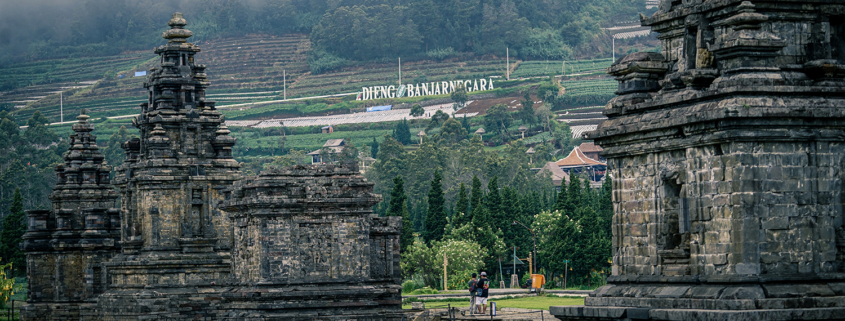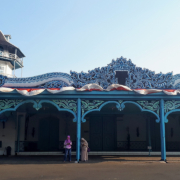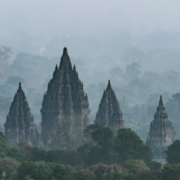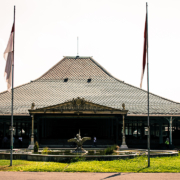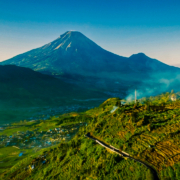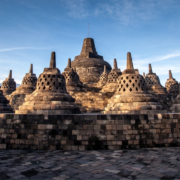Arjuna Temple Cluster: Ancient Hindu Sanctuaries of the Mystical Dieng Plateau
Perched over 2,000 meters above sea level amidst steaming volcanic craters and mist-laden valleys, the Arjuna Temple Cluster on the Dieng Plateau is one of the oldest surviving Hindu temple complexes in Indonesia. Built during the 7th–8th centuries, these stone sanctuaries represent the early spiritual and architectural expressions of Hinduism on Javanese soil—predating even the majestic Borobudur and Prambanan. Though modest in size, the temples radiate a deep, atmospheric sacredness, evoking an era when divine worship harmonized with volcanic forces and sky-touching altitudes.
Historical Background
The Dieng Plateau, whose name is derived from the Old Javanese “Di Hyang” meaning “Abode of the Gods,” was a sacred region long before the arrival of Islam or Buddhism. Around the 7th century, the Kalingga and later Sanjaya dynasties of early Central Java began to construct temples in the highlands of Dieng as both a spiritual center and a royal sanctuary.
The Arjuna Temple Cluster is believed to have been built during the early Mataram Kingdom period, making it one of the earliest examples of Indianized temple construction in the Indonesian archipelago. These temples primarily honor Lord Shiva and exhibit classic North Indian architectural influences, but with uniquely Javanese adaptations.
Architectural Features
The Arjuna complex consists of several small yet distinct temples spread across an open plain. The five primary temples are:
- Arjuna Temple – The central and oldest temple, rectangular in shape, dedicated to Shiva.
- Srikandi Temple – East of Arjuna, associated with Durga or possibly Vishnu depending on interpretations.
- Puntadewa Temple – Named after a Pandava prince, it mirrors similar forms but lacks significant ornamentation.
- Sembadra Temple – Dedicated to Sembadra (Draupadi), believed to be the consort of Arjuna.
- Semar Temple – A small auxiliary shrine in front of Arjuna Temple, possibly used as a meditation chamber or for housing sacred objects.
These temples are constructed from andesite stone and are modest in scale, standing only a few meters tall. Unlike the ornate reliefs of later temples like Prambanan, these early structures are austere and geometric, emphasizing verticality and balance over decorative detail.
Symbolism and Spiritual Function
Though compact, the Arjuna temples encode profound cosmic and metaphysical ideas:
- Shiva Worship: The primary deity enshrined here is Shiva, particularly in his manifestation as a lingam, symbolizing generative power and cosmic stillness.
- Cosmic Axis: Built at a high-altitude location near sulfur vents and thermal activity, the temples were thought to align with celestial and geological energies—serving as a meeting point between the heavens, earth, and the netherworld.
- Mountain as Mandala: The Dieng Plateau itself functioned as a sacred landscape—like a natural mandala—where the temples formed the energetic heart of a divine grid.
Cultural and Mythological Resonance
According to local lore, the Pandava heroes of the Mahabharata once meditated in Dieng, which inspired the naming of the temples after them. The area has long been considered a place of divine purification, and ancient kings and priests made pilgrimages here to perform ascetic rites and tantric rituals in solitude and silence.
Additionally, nearby geothermal features—like the Sikidang Crater and Telaga Warna (Color-Changing Lake)—add a mystical dimension to the region. The interplay of sacred temples, sulfurous mists, and volcanic tremors blurs the line between the physical and the supernatural.
Modern Significance and Access
Today, the Arjuna Temple Cluster is one of the most visited attractions on the Dieng Plateau, drawing not only tourists but also spiritual pilgrims, archaeologists, and energy seekers. The temples are often included in traditional Javanese ceremonies and annual festivals, such as the Dieng Culture Festival, where rituals like rambut gimbal cutting (shaving dreadlocks from special village children believed to possess mystical gifts) are held.
Visitor Information
- Location: Dieng Plateau, Wonosobo/Banjarnegara Regency, Central Java
- Best Time to Visit: Early morning, when the mist rises and the light bathes the temples in gold; dry season (June–August) is ideal.
- Nearby Sites: Sikidang Crater, Telaga Warna, Batu Pandang Ratapan Angin, and other lesser-known temple ruins like Gatotkaca and Dwarawati.
- Tips:
- Dress warmly—temperatures can drop below 10°C in the morning.
- Walk mindfully—the spiritual charge of the land is subtle but powerful.
The Arjuna Temple Cluster is not simply a historical remnant—it is a threshold into ancient spirituality, where the early pulse of Hindu devotion first beat in the Javanese highlands. Surrounded by clouds, fire, and silence, these temples offer a rare glimpse into a time when gods were invited to dwell in volcanic temples and the mountains whispered mantras to the sky. For those drawn to the primal origins of sacred architecture in Indonesia, Arjuna is a gateway to both the past and the eternal.

